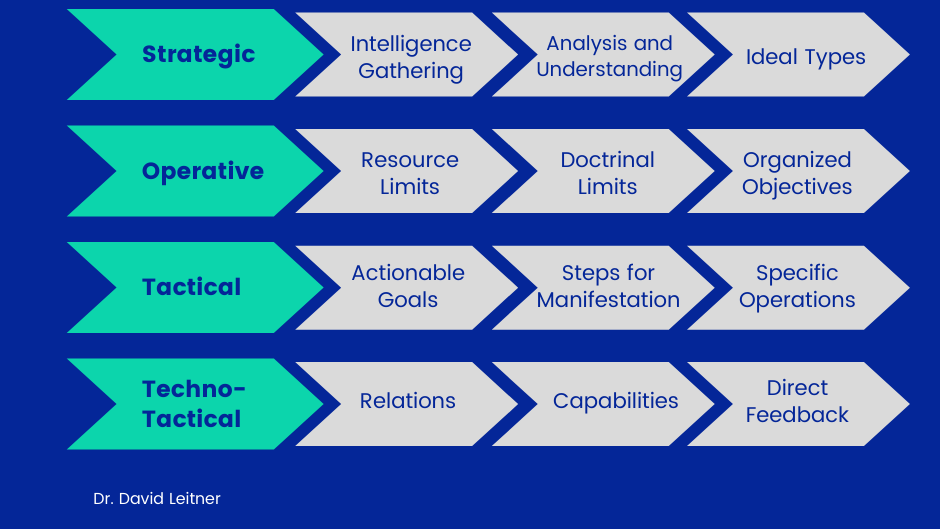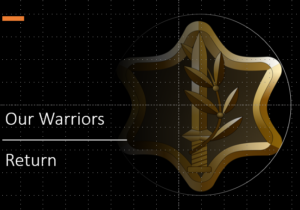We talk a lot about goals in the world of leadership and strategy. How it’s important to use some system for setting goals. How goals provide the team or the individual a clear understanding of the expected outcome and the parameters for work.
Based on Luttwak’s hierarchy we can argue that there are different types of “goals” for different levels of engagement. Another way to look at these different “goals” is to discuss the timeframe involved. Another way to delineate them might be the nature of the resources and doctrine delineating acceptable and available action.

So, it is not enough to talk about goals. We need to expand the discussion. To do that, we need to consider different terminology – because talking about “goals” for different levels or types of engagement can get confusing. We need to talk about how tasks, goals, and objectives work together for purpose.
Using Luttwak’s hierarchy or a creative process as the framework for understanding, let’s look at how the hierarchy might differentiate between the different levels and the nature of the “goals.”
Tasks build Goals
At the techno-tactical, where we find the individual workers and specific skills, we assign tasks. It is here that leadership will assign people with the right skills, background, and knowledge, to accomplish a specific task. And each of these tasks is a building block of a specific goal. So, tasks are specific endeavors undertaken utilizing specific skills that, with other tasks, work to achieve a specific goal.
One of the easiest ways to assign tasks is to use the CLEAR system – Collaborative, Limited, Emotional, Appreciable and Refinable. This allows the follower to understand who they should work with for the task and what others are working on, which also allows them to understand the limits and scope of their task and what is not part of their purview. This helps to create an emotional attachment to the work and establish ownership, define clear and easy to recognize markers for success that the leadership can acknowledge, and allows the nature of the task to be refined and adjusted as obstacles or successes impact the work on the task. But these tasks are not the end purpose. They work to achieve specific goals.
Goals build Objectives
Goals, then, fall within the realm of the tactical. Goals represent the unified effort of team members maneuvering together – whether on the battlefield or in the office – to accomplish a specific mission. The individual tasks each make up a part of the goal, and each team member is relying on the others to uphold their part of the mission. This requires a great deal of trust and communication between the different individuals involved. While everyone will work at their own pace, leadership will work with the individuals to overcome specific obstacles or to encourage them based on their developmental level.
So, each goal is a conglomerate of different tasks working together to accomplish a specific maneuver. And each team member understands their part in the mission and that there are time limits impacting outcome. The leadership makes clear that everyone needs to accomplish their part or let others know what is making it difficult for them to achieve a specific signpost on the mission parameters. Thus, goals are set to provide clear expectations for the tactical maneuver and make sure that the team members know the overall mission and how their tasks are designed to take part in accomplishing that mission.
One of the classic systems for setting goals is the SMART system. In order for the maneuver to succeed the goals need to include a specific outcome with clear metrics delineating success. I’ve heard leadership suggest that goals need to be strategic. Unfortunately, many people do not understand what that means and/or will then try to set wildly important goals or WIGS for teams that need SMART goals, not objectives. To be clear goals are not objectives. As for metrics – that is a function of what can be measured in relation to the goal. Basically, when leadership sets goals, they need to let the followers know their expectations and how they will determine success.
Now, many people will tell you that leadership should only set a goal if it is attainable. But that concept only has worth in a system of known variables. I would argue that the people involved need to feel like the goal is attainable given their skills, the resources at their disposal, and the values that are limiting action. That doesn’t mean a goal cannot be ambitious. On the contrary – ambitious goals are worthwhile. But the team members need to feel like the leadership understands the risks and obstacles and is providing an environment where failure is not a given. So, the goal needs to be assigned to someone or a team that feels like it can accomplish the mission at hand.
So Specific (not strategic), Measurable/Metrics, and Attainable but Ambitious. That covers SMA of the SMART system, but what about RT? And what about objectives?
Again – here it will depend on who you ask. Some people argue for Realistic as a part of setting a goal. But realistic goals may hinder leadership’s willingness to take risk and limit their undertaking ambitious maneuvers that engage opportunity. Relevancy, on the other hand, depends on the nature and skills of the followers. Leadership that sees a goal as relevant to the objective and that followers will see as relevant to their work are more likely to engage in maneuvers and take risks – especially if they understand how their tasks are relevant and will impact outcome.
Lastly, goals are differentiated from tasks and objectives by the timeframe involved. While tasks are short term actions that utilize specific skills, goals represent important stepping-stones in attaining an objective. As such, timeframes for goals must acknowledge that reality will not necessarily present an absolute but set an ideal type based on experience. But that requires not only experience but also an understanding of how reality will impact outcome. Another way to look at the last measure for goal setting is testable. By setting a timeframe and establishing testability we can now know when we expect results and create the feedback loop that will allow others to determine if we have succeeded in the mission parameters.
Now you might be asking something like “How does testable work in the military?” Good questions. We test the validity of the mission in relation to the further movement towards an objective. If we were successful then our next iteration should include advances that are not hindered, and are even supported by, the previous mission’s goals. And that lets us utilize these goals for the purpose of achieving an objective.
Objectives create Vision
So, then what are Objectives? Objectives are the focus of the operative. Operative analysis theory determines how to move towards a vision. So, this analysis determines how the organization is going to move forward and prioritize around what is important for creating a future that meets vision.
At the tactical there may be multiple teams working on specific goals or one team working on a set of goals, but the purpose of these goals it to achieve a specific objective – a major stepping-stone on the path to success.
We resource specific objectives and delineate clear values for how those resources can be used to obtain those objectives. At the operative we recognize that different goals must be met and make sur that team leaders are actively aware of how their goals impact the objective. In military settings, objectives represent what Clausewitz called centers of gravity that must be controlled in the dialogued use of force. They are the crossroads, high ground, and major landmarks that we must hit for us to move into the next stage of an campaign.
These objectives provide the playbook of potentiality. That potentiality is delineated by what Dr. Andy Grove defined as Objectives and Key Results (OKRs). John Doerr argues that Objectives with their associated Key Results are the building blocks of creating the world we want. They delineate “WHAT is to be achieved” while “KEY RESULTS benchmark and monitor HOW we get to the objective.”[1] These Objectives, and their key results, provide direction and a measure for success that will be of import for the agent in the field as they undertake operations. For Grove the core of this concept is not what you know or the Vision, but rather the capacity to execute the idea and bring it fruition.
As Clausewitz wrote, “Out of these characteristics, a certain center of gravity develops, the hub of all power and movement, on which everything depends. That is the point against which all our energies should be directed.”[2]
We resource specific objectives and delineate clear values for how those resources can be used to obtain those objectives. At the operative we recognize that different goals must be met and make sur that team leaders are actively aware of how their goals impact the objective. In military settings, objectives represent centers of gravity that must be controlled in the dialogued use of force. They are the crossroads, high ground, and major landmarks that we must hit for us to move into the next stage of an campaign.
How does setting objectives differ from tasks or goals. The nature of the objectives must be PURE – normally Positively stated, Understood, Relevant, and Ethical I have a slightly different take: Prioritized with purpose, Understood, Resourced, and Ethical
In this case I tend to hold that the objective needs to be attached to a specific purpose. Why are we trying to hit this objective? What will it do for the overall campaign? How will it help fulfill the purpose of our organization as it is presently engaged? How will it help create our vision in the world? As part of this discussion, leadership needs to decide how to prioritize the different objectives. Can they be worked on simultaneously or must they be undertaken sequentially? This will depend on how the leadership understands objectives – are the resource based, doctrine based, or effect based.
Resource Based Objectives
Resourced based discussions often start with someone saying something like “well here are the different resources we have available, so let’s try to do objective X and Y since we have the means to do that.” After determining what resources are available the discussion will turn to the question of which of these is more important and why – which is an ethical judgement that tries to fit decision making into the value system of the organization. That is, a judgement about what to prioritize is dependent on what is of import to the group. Then the desired effect is established based on what the resources allow.
In a resource-based system, the amount of resources (time, money, human resource, and more) available will determine prioritization and also if objectives can be tackled simultaneously or must be dealt with sequentially (for the most part). If the organization has an abundance of resources they may be inclined to undertake multiple objectives at the same time. If they are resource light, then they will probably try to do a sequential prioritization and implementation process – simply because they do not have the necessary resources to do everything at the same time. But when we consider time as the primary resource we may find that it does not permit for sequential objectives and, as such, may demand a significant drain on other resources as time limitations require multiple objectives be engaged.
Doctrine Based Objectives
In contrast, leadership that sets objectives based on doctrine will look at what is important to the moral fiber of the organization and then determine what resources they should use to meet that value statement. Organizational cultures sometimes set objectives this way by looking at things like the environmental impact or social impact they feel is important, so their conversation will start with an examination of which values they most want to see expressed in the world and then delineate which resources should be used given these limitations. Thus, the leadership establishes first what is important morally, then what resources, and lastly the effect they expect given the combination of those two.
In this system, resources may be abundant, but the organization chooses to focus on one or two critical objectives, either sequentially or simultaneously. These doctrinally driven objectives may not utilize a preponderance of the resources available. But sometimes specific objectives call of the full focus of the organization. Called “North Star Objectives,” these are set above all others and garner the full weight of the organization in question. These objectives are established by what is most important for the organization and are often based in doctrine, not the effect they will have on the Other (client, enemy) and are sometimes defined by how they will change the organization itself, not the environment in which they are working.
Effect Based Objectives
The last system for creating and prioritizing objectives is neither resource nor doctrine based. Instead setting and prioritizing these objectives is established first and foremost by the desired effect. This is, to my mind, the best way to establish operative objectives. Rather than letting resources dictate what is feasible or doctrine what is morally acceptable and permissive we look to see how we want to change the world and what effect we want to have on it. This type of objective often starts with a conversation about vision and purpose and then digs down into how to create change to achieve that purpose. It doesn’t yet care if we have the resources, and it isn’t asking if the proposed objectives meet the doctrinal values. Those questions will only come into play after we know the effect we want to have.
Then leadership looks to balance the desired effect with the resources and doctrine. Here it often depends on how resource rich or doctrinally strict the leadership of organization is and whether they are able to hold to their established beliefs or use the resources they have or can get in order to have the effect they desire.
So, while a doctrine heavy organization might look at doctrine to determine if the objectives are acceptable and if there are any that might need to be re-prioritized or eliminated. A resource heavy organization’s leadership might seek to determine what resources can be put to which objectives given the desired objectives.
Either way, the resource-doctrine divide will find an equilibrium that allows for the desired effect – to a point. Clearly, in each of these series there is also an understanding, even a likelihood, that leadership will have to procure resources that will cause the desired effect and that those resources must work within the limits that doctrine has set. And there may be times that leadership questions the doctrine that is guiding their decision-making.
By establishing and prioritizing objectives, the operative leadership makes clear how the tactical goals are going to help achieve the objective and work towards a greater purpose. They work to make sure each team leader understands their part and how the goal set for them works within the framework of the overall objective. The operative leadership then needs to determine which resources will be at the disposal for each team and find out if the team leaders feel like there are additional resources needed for mission control. Lastly, the operative leadership needs to establish what they consider to be ethical behavior for the teams and how they expect the teams to engage with their missions. So, while tasks need to be CLEAR and goals need to be SMART, I believe it is wise for objectives to be PURE.
Working with Reality
Objectives, while taking into consideration the environment and reality, need to have a purity to them that clearly distinguishes why it is acceptable and necessary for the teams to work towards this purpose. That purity allows team leaders to establish ownership of their part and take on mission control without needing to continually check back in for further orders. It also allows the teams to know why they are being asked to undertake their mission and gives team leaders the ability to speak to a higher purpose that can help overcome any emotional obstacles that might hinder top-notch performance by team members.
In the military, the purity of the objectives makes the possibility of sacrifice palpable, even acceptable.
Together these objectives will create a future that meets or comes close to the ideal type, the vision, and aligns with purpose. This is the primary focus of strategic leadership. Leadership is the process of getting other to follow and work together towards a mutual vision, purpose, objective, or goal. Understanding the differences between these, and how to utilize different systems, styles, and skills to enhance the understanding and acceptance of these, can help leadership to work with their teams and team leaders and understand where obstacles are impeding progress.
And that gives leadership a measure of how to help their followers undertake exemplary action.
[1] J. Doerr, Measure What Matters: OKRs: The Simple Idea That Drives 10x Growth (Penguin Books Limited, 2018). Chapter 1, page 7/24.
[2] Clausewitz, On War. 595-596.




